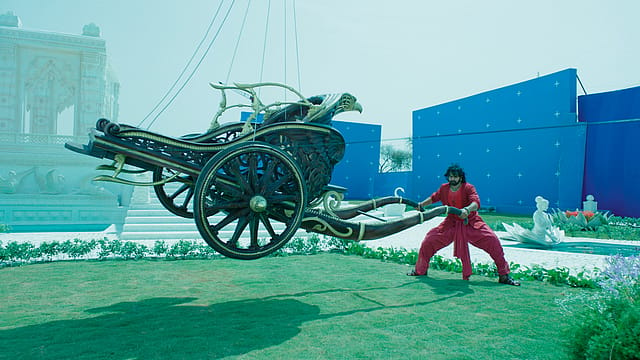VFX: Waiting for a marvel
ADVERTISEMENT

A group of expectant Marvel fans sit in an auditorium which is screening Avengers: Infinity War. The movie ends and the credits roll up. Under the animation and visual effects (VFX) section, they spot many Indian names and soon get into an animated discussion. This is a common scene nowadays; pick any VFX-heavy Hollywood movie, you’ll probably find Indian names in the credits.
It is no secret that Hollywood has been tapping India for quality VFX work and talent. In fact, international projects account for 73% of the revenue of the VFX industry in India, says a 2017 KPMG India-FICCI report. One of the big players is redchillies.vfx, the post-production studio of Shah Rukh Khan’s movie production company, Red Chillies Entertainment, which has worked for some top Hollywood films such as Sin City 2 (2014). Another is Prime Focus World, which merged with London-based Double Negative, a multiple Oscar-winning VFX studio with several Indians on its teams that worked on Pacific Rim Uprising (March 2018) and Avengers: Infinity War (April 2018). Since their merger in 2014, the two have shared talent and technical knowledge, greatly adding to the chops of artists in India, says the BSE-listed Prime Focus, which owns Prime Focus World.
Indian VFX firms might produce top-notch content for Hollywood, but the visual effects in Indian films don’t always match global standards. The reason is simple: budgets. “There is no comparison with the budgets of Hollywood,” says Keitan Yadav, chief operating officer and VFX producer, redchillies.vfx. “The budgets in Hollywood are six to 10 times that of Bollywood. Filmmakers in the West have millions of dollars at their disposal for big budget films; compare that to Rs 30-40 crore we spent on VFX for a Ra.One or Fan. There is a huge difference.” To be sure, the VFX in Shah Rukh Khan-starrer Ra.One won redchillies.vfx a national award. Fan, which had Khan playing the part of a man younger and smaller in build, too, was noted for its VFX, says Red Chillies Entertainment CEO Venky Mysore.
December 2025
The annual Fortune 500 India list, the definitive compendium of corporate performance, is out. This year, the cumulative revenue of the Fortune 500 India companies has breached $2 trillion for the first time. Plus, find out which are the Best B-schools in India.
Jehil Thakkar, partner at Deloitte, says without budgets of $150-200 million (over Rs 1,000 crore), catching up with Hollywood will be tough. “Take a look at our box office, a film that makes Rs 200 crore is considered a huge hit. But if we translate that to U.S. dollars, it’s hardly around $25 million,” he says, adding that if four-five Indian films make Rs 500 crore in the domestic market, then “we will be able to see the standard of VFX rise substantially”.
Scenes from Hong Kong-Chinese movie Feng Shen Bang before and after VFX. redchillies.vfx worked on the VFX in these movies.
But discerning Indian audiences don’t care about the difference in budgets; they want the same standards of film-making and visual effects as Hollywood. Merzin Tavaria, co-founder of Prime Focus, says Hollywood superhero films, especially Hindi-dubbed versions, pose serious competition to Indian films. “When you have films like Avengers running on an adjacent screen in a multiplex, you must be able to ensure your VFX are of that level in order to compete,” he says.
The industry faces other challenges. Pete Draper, co-founder of Hyderabad-based Makuta VFX, which worked on S.S. Rajamouli’s Baahubali 1 and 2, says there is a lack of awareness among filmmakers in India about visual effects. “I get asked ‘How much for 30 minutes of VFX?’ often. That’s like asking ‘How much for a meal?’ without specifying what kind. I could give you three minutes of a rotating box and it wouldn’t cost much, or I could give you three minutes of 10,000 people on horseback in battle and that would cost much more,” he explains.
Then there is the matter of time. Some years ago, a VFX studio in India flew in a U.S. animator to discuss a project. An especially VFX heavy movie for the times, expectations were high; the Indian studio thought it needed a second opinion. The U.S. animator said the job would take three years. But the studio needed it done in 11 months. The grapevine has it his parting words were “good luck”. Though left in the lurch, the studio hit the ground running and finished the project on time.
But Indian film-makers are coming around to the demands of VFX. Makuta’s Draper explains that the team working on Baahubali 1 spent a year on a sequence depicting the protagonist climbing a gigantic waterfall: It is just a five-minute scene on the big screen.
The success of flicks such as Baahubali has convinced producers about the importance of good visual effects. “If producers were willing to spend only 5-10% of the total film’s budget on VFX a decade ago, now some are okay with spending 15-20%,” says Prime Focus’ Tavaria.
Demand for visual effects has also grown as the big screen no more remains the only stage for movie-makers to tell stories. “With the rise of platforms such as Netflix, the quantum of work for the VFX industry has increased,” says Yadav of redchillies.vfx. “Although the cost of standard VFX processes had remained more or less constant, what has changed is the will of filmmakers to invest more when they come across a script that requires heavy VFX work like fantasy, mythology, sci-fi, and horror.”
A movie with such a script is in the works. Randamoozham, a retelling of the epic Mahabharata, has a Rs 1,000 crore budget, more than twice that of both Baahubali 1 and 2 (Rs 430 crore). The two-part multilingual movie promises a feast of top-notch visual effects.
